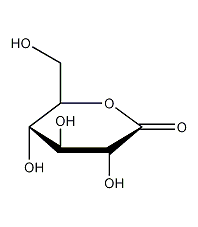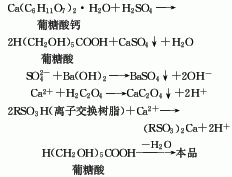
Structural formula
| Business number | 022Q |
|---|---|
| Molecular formula | C6H10O6 |
| Molecular weight | 178.14 |
| label |
D-glucono delta-lactone, 1,2,3,4,5-pentahydroxycaproic acid δ-lactone, D-(+)-Gluconic acid δ-lactone, δ-Gluconolactone, Ester cyclic compounds and their derivatives |
Numbering system
CAS number:90-80-2
MDL number:MFCD00006647
EINECS number:202-016-5
RTECS number:LZ5184000
BRN number:83286
PubChem number:24895183
Physical property data
1. Properties: White crystalline powder, odorless or slightly odorless.
2. Density (g/mL, 25/4℃): 1.760
3. Relative vapor density (g/mL, air=1): Undetermined
4. Melting point (ºC): 117.8
5. Boiling point (ºC, normal pressure): Undetermined
6. Boiling point (ºC, 5.2kPa): Undetermined
7. Refractive index: Undetermined
8. Flash point (ºC): Undetermined
9. Specific rotation (º): Undetermined
p>
10. Autoignition point or ignition temperature (ºC): Undetermined
11. Vapor pressure (kPa, 25ºC): Undetermined
12. Saturated vapor pressure (kPa, 60ºC): Undetermined
13. Heat of combustion (KJ/mol): Undetermined
14. Critical temperature (ºC): Undetermined
15. Critical pressure (KPa): Undetermined
16. Log value of oil-water (octanol/water) partition coefficient: Undetermined
17. Explosion upper limit (%, V /V): Undetermined
18. Lower explosion limit (%, V/V): Undetermined
19. Solubility: Easily soluble in water, and slowly hydrolyzed in water The solubility is 59g/100ml, slightly soluble in ethanol, 1g/100ml in ethanol, and insoluble in ether.
Toxicological data
This product is non-toxic. In 1933, the US FDA approved it as a non-toxic food additive.
Ecological data
None
Molecular structure data
1. Molar refractive index: 35.79
2. Molar volume (cm3/mol): 103.5
3. Isotonic specific volume (90.2K ): 326.0
4.Surface tension (dyne/cm): 98.4
5, Polarizability (10-24cm3): 14.19
Compute chemical data
1. Hydrophobic parameter calculation reference value (XlogP): -2
2. Number of hydrogen bond donors: 4
3. Number of hydrogen bond acceptors: 6
4. Number of rotatable chemical bonds: 1
5. Number of tautomers:
6. Topological molecular polar surface area (TPSA): 107
p>
7. Number of heavy atoms: 12
8. Surface charge: 0
9. Complexity: 181
10. Number of isotope atoms : 0
11. Determine the number of atomic stereocenters: 4
12. Uncertain number of atomic stereocenters: 0
13. Determine the chemical bond configuration Number of centers: 0
14. Number of uncertain chemical bond stereocenters: 0
15. Number of covalent bond units: 1
Properties and stability
This product is non-toxic. In 1933, the US FDA approved it as a non-toxic food additive.
Storage method
This product should be kept sealed. Plastic bag packaging. Store and transport according to general chemical regulations.
Synthesis method
1. The raw material calcium gluconate is first hydrolyzed with sulfuric acid to obtain gluconic acid solution. The calcium sulfate precipitate is removed by filtration, and then the solution is refined with barium hydroxide and oxalic acid, and separated by sedimentation to remove SO42- and Ca2+ in the solution. The gluconic acid solution is then passed through an ion exchange resin to further purify it. Concentrate the solution to a concentration of 80%-85%, add glucono-delta-lactone seed crystals, continue to concentrate and crystallize, centrifuge, wash with water, and dry to obtain the finished product.

2.Calcium gluconate is first hydrolyzed with sulfuric acid to obtain gluconic acid solution. The calcium sulfate precipitate is removed by filtration, and then the solution is refined with barium hydroxide and oxalic acid, and separated by sedimentation to remove SO42- and Ca2+ in the solution. The gluconic acid solution is then passed through an ion exchange resin to further purify it. Concentrate the solution to 80% to 85%, add glucono-δ-lactone seed crystals, continue to concentrate and crystallize, and obtain it by centrifugation, washing with water, and drying.
Purpose
1. Used as tofu coagulant; flavoring agent; raw material of pH lowering agent and leavening agent. In Japan, tofu coagulant accounts for 50%-70% of the total usage in Japan. Using this product to make tofu has a pure texture, is tender and delicious, and can extend the storage time. my country’s hygienic standard for the use of food additives (GB2760-86) stipulates that the maximum usage amount is 3.0g, kg. Gluconolactone is used in the milk industry to prevent the formation of milk stones. In the brewing industry, it is used as a preventive agent for beer stones. It is added to toothpaste to help remove tartar. In addition, it is also used in livestock meat; metal surface treatment agent, etc.
2.Used as stabilizer, coagulant, sour agent and chelating agent. It is used in soy products (tofu and tofu curd), sausages (meat sausages), surimi products and grape juice, with a maximum dosage of 3.0g/kg; as a preservative, the maximum dosage used to preserve fish and shrimp is 0.1g/kg. kg, the residual amount is 0.01 mg/kg; it can also be used as a leavening agent for preparing compound baking powder, and should be used in appropriate amounts according to production needs.


